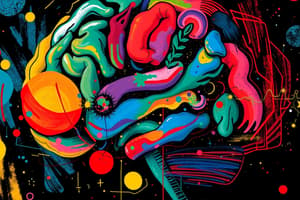Podcast
Questions and Answers
What function does the primary auditory cortex perform?
What function does the primary auditory cortex perform?
- It transforms electrical signals into recognizable words.
- It coordinates visual and auditory stimuli.
- It processes the meaning of sounds and music.
- It receives electrical signals and creates meaningless sound sensations. (correct)
Where is the auditory association area located in relation to the primary auditory cortex?
Where is the auditory association area located in relation to the primary auditory cortex?
- On the right side of the primary auditory cortex.
- On the left side of the primary auditory cortex.
- Below the primary auditory cortex. (correct)
- Above the primary auditory cortex.
What type of information does the auditory association area transform?
What type of information does the auditory association area transform?
- Visual patterns into meaningful sounds.
- Meaningful sounds into visual representations.
- Complex sentences into simple phrases.
- Basic sensory information into recognizable auditory information. (correct)
Which area of the brain is likely involved in reading disorders?
Which area of the brain is likely involved in reading disorders?
How does the planum temporale differ in individuals with reading disorders compared to normal brains?
How does the planum temporale differ in individuals with reading disorders compared to normal brains?
What areas of the brain show lower activation in dyslexic children compared to non-impaired children?
What areas of the brain show lower activation in dyslexic children compared to non-impaired children?
What does the three-part center in the brain accomplish once a word is learned?
What does the three-part center in the brain accomplish once a word is learned?
What type of deficits are suspected to be genetically based?
What type of deficits are suspected to be genetically based?
What is a primary function of the inferior frontal gyrus in the context of dyslexia?
What is a primary function of the inferior frontal gyrus in the context of dyslexia?
How do memory impairments in children with learning disorders impact their recall abilities?
How do memory impairments in children with learning disorders impact their recall abilities?
What brain regions are specifically affected in children with reading disorders when processing auditory information?
What brain regions are specifically affected in children with reading disorders when processing auditory information?
Why do children with learning disorders have difficulty distinguishing certain sounds?
Why do children with learning disorders have difficulty distinguishing certain sounds?
What is the consequence of a subtle neurological deficit in sound frequency sensitivity?
What is the consequence of a subtle neurological deficit in sound frequency sensitivity?
Which cognitive deficit is primarily associated with specific learning disorders (SLD) in mathematics?
Which cognitive deficit is primarily associated with specific learning disorders (SLD) in mathematics?
What is subitizing, and how is it affected in children with learning disorders?
What is subitizing, and how is it affected in children with learning disorders?
What are the two major findings regarding the biological underpinnings of reading disorders?
What are the two major findings regarding the biological underpinnings of reading disorders?
How do children with mathematics disorders perform compared to their peers when recognizing larger numbers?
How do children with mathematics disorders perform compared to their peers when recognizing larger numbers?
What might cause someone to have an expressive language problem despite good comprehension skills?
What might cause someone to have an expressive language problem despite good comprehension skills?
Which aspect of visual processing is particularly deficient in adults with reading disorders?
Which aspect of visual processing is particularly deficient in adults with reading disorders?
Flashcards are hidden until you start studying
Study Notes
Auditory Cortex and Processing
- The primary auditory cortex, located on the top edge of each temporal lobe, processes electrical signals from the ears into basic sound sensations.
- The auditory association area, situated below the primary auditory cortex, converts these basic sounds into recognizable forms like words or music through pattern matching.
- The planum temporale is a crucial language-related brain structure, exhibiting size differences in typically developing brains; the left side is larger than the right, which is not the case in individuals with reading disorders.
Dyslexia and Brain Activation
- Dyslexic children show lower activation levels in several brain areas, including the inferior frontal, parieto-temporal, and occipitotemporal gyri, which are pivotal for understanding phonemes, analyzing words, and word recognition.
- Short-term and working memory deficiencies are prevalent in children with learning disorders, affecting their recall and processing of phonemes and numbers.
Phoneme Processing and Musical Recognition
- Children with learning disorders struggle with rapid phoneme distinctions, analogous to how individuals categorize and recognize music.
- Unique neurons in language-processing areas react differently depending on tasks, causing expressive language issues despite comprehension abilities.
Visual Processing Deficits
- Adults with reading disorders display inertness in visual motion areas, indicated by a lack of activation when observing moving dots.
- Impaired ability to detect rapid sound changes contributes to reading and phonological processing challenges, underpinning critical biological factors behind reading disorders.
Specific Learning Disabilities (SLD)
- Research predominantly focuses on reading disabilities, but findings extend to writing and mathematical disorders.
- Cognitive deficits in number concepts underlie SLD in mathematics, similarly to how phonological awareness issues relate to reading disabilities.
- Children with SLD in mathematics struggle with rapid visual processing tasks, such as subitizing groups of dots, indicating an underlying deficit.
Nonverbal Learning Disability (NLD)
- NLD is characterized by difficulties in right-hemisphere functioning, linked with poor mathematical skills and social/emotional challenges.
- Deficits associated with NLD include poor coordination, judgment, and navigating complex situations, distinguishing it from traditional SLD, although its uniqueness remains debated.
Studying That Suits You
Use AI to generate personalized quizzes and flashcards to suit your learning preferences.



